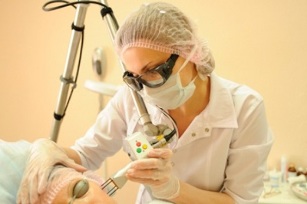
Fractional regeneration involves the use of a laser. This is a very complex procedure that solves a wide range of skin problems that inevitably arise as the body ages. Requires high professionalism from the specialist who manages it. Only a specialist with medical education and completed courses to work with laser equipment has the right to perform laser rejuvenation. Performing the procedure in a controversial clinic with an unqualified cosmetologist, you can get a negative effect instead of the desired rejuvenation.
Fragmented laser treatment is a worthy option for those looking for ways to rejuvenate the face without surgery. By the way, this method is used not only on the face but also on the body. In particular, using a laser, it is possible to make scars and stretch marks invisible. So laser rejuvenation will be interesting for those who have long been interested in the problem of how to remove stretch marks on the body.
Varieties of fractional laser rejuvenation
The fractional laser does not send a single ray, but many microscopic rays, allowing you to act on the skin more delicately and delicately.
Fractional laser refurbishment is divided into two types:
- The first type of fractional rejuvenation is often called laser reappearance. During such reappearance, the laser removes very small areas of the upper layer of skin, located at a certain distance from each other. This activates the regenerative processes in the skin. This procedure uses a carbon dioxide laser.
- The second type of fractional rejuvenation is the effect of the best rays on areas of the skin that are at a strictly defined depth. At the same time, the surface of the skin is not exposed to injury, and in the deeper layers of the skin, collagen production is activated and laser-removed areas of skin are filled with new cells.
Different clinics use different types of lasers, but the principle of the laser rejuvenation method is the same in all cases: causing controlled skin damage, stimulating it to heal, and actively rejuvenating.
In each specific case, the doctor looks at which laser technique will be most appropriate. Before each procedure, the laser is adjusted individually for each patient.
Skin care after partial skin rejuvenation

The doctor who performed the procedure will show you how to take care of your skin after laser rejuvenation. The choice of cosmetic products depends on the type of skin, its individual characteristics, as well as the tasks and the degree of the procedure performed.
On days 2-3 after the session, a crust forms on the skin, which rejects within 3-4 days. At this time, it is necessary to use the cream recommended by the doctor. Then, for 1-2 months, it is necessary to put a good sunscreen on the skin before going out, and use a nourishing regenerating cream at night.
Importantly, laser rejuvenation not only corrects existing age-related changes, but also further slows down the aging process itself, triggering the mechanism of skin cell renewal.
For whom is fractional renewal suitable and with which procedures is it combined
The procedure is always performed only after prior consultation with a specialist. With markedly age-related changes, laser reappearance will be more appropriate, rather than laser rejuvenation. In some cases, it is impossible to do at all without plastic surgery: blepharoplasty, endoscopic face lift or insertion of lifting threads. But even here, hardware techniques, in particular, laser rejuvenation, will help increase and maintain the effect.
Plasmolifting and mesotherapy are perfectly combined with laser techniques, including biorevitalization with hyaluronic acid.Laser rejuvenation procedure is not suitable for pregnant and lactate women, people suffering from cancer, diabetes mellitus, severe hypertension, psoriasis and dermatoses. Herpetic rashes and inflammatory processes in the affected area are also a contraindication to the procedure. Laser renewal is not recommended for people with keloid scars or a family history of vitiligo.





















